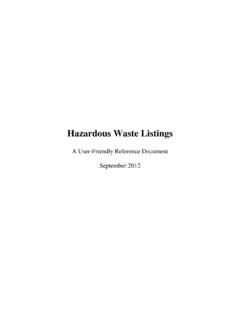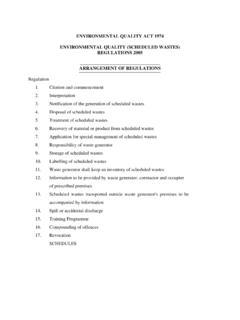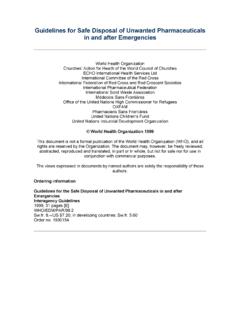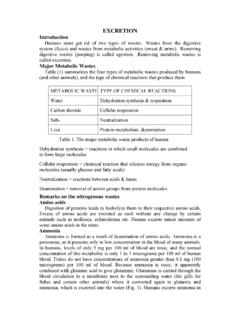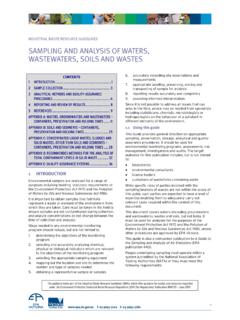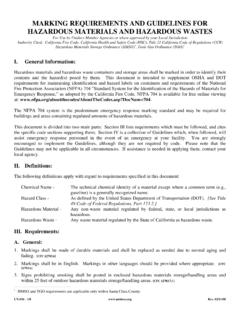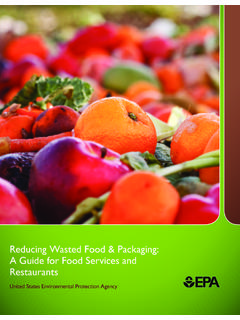Transcription of Global food losses and food waste - Food and Agriculture ...
1 Study conducted for the International CongressSAVE FOOD!at Interpack2011D sseldorf, Germanyextent, causes and preventionGlobalfoodlossesandfoodwasteGl obalfoodlossesandfoodwasteFOOD AND Agriculture ORGANIZATION OF THE UNITED NATIONSRome, 2011byJenny GustavssonChristel CederbergUlf SonessonSwedish Institute for Food and Biotechnology (SIK)Gothenburg, SwedenandRobert van OtterdijkAlexandre MeybeckFAORome, ItalyStudy conducted for the International CongressSAVE FOOD!at Interpack2011D sseldorf, Germanyextent, causes and preventionThe designations employed and the presentation of material in this information product do not imply the expression of any opinion whatsoever on the part of the Food and Agriculture Organization of the United Nations (FAO) concerning the legal or development status of any country, territory, city or area or of its authorities, or concerning the delimitation of its frontiers or boundaries.
2 The mention of specific companies or products of manufacturers, whether or not these have been patented, does not imply that these have been endorsed or recommended by FAO in preference to others of a similar nature that are not views expressed in this information product are those of the author(s) and do not necessarily reflect the views of 978-92-5-107205-9 All rights reserved. FAO encourages the reproduction and dissemination of material in this information product. Non-commercial uses will be authorized free of charge, upon request. Reproduction for resale or other commercial purposes, including educational purposes, may incur fees.
3 Applications for permission to reproduce or disseminate FAO copyright materials, and all queries concerning rights and licences, should be addressed by e-mail to or to the Chief, Publishing Policy and Support Branch, Office of Knowledge Exchange, Research and Extension, FAO, Viale delle Terme di Caracalla, 00153 Rome, Italy. FAO 2011 Cover photos: Jonathan Bloom and Nick SaltmarshDesign: Simone MoriniRecommended citationFAO. 2011. Global food losses and food waste Extent, causes and prevention. RomeiiiContentsPreface ivExecutive summary v1.
4 Introduction 12. Methodology 2 Definition of food losses and food waste 2 Types of food losses and food waste 2 Quantification of food losses and waste 33. Extent of food losses and waste 4 Food volumes produced 4 Extent of food losses and waste 44. Causes and prevention of food losses and waste 105. Conclusions 15 References 16 Further reading 17 Annexes 23ivPrefaceThis publication is based on studies carried out from August 2010 to January 2011 by The Swedish Institute for Food and Biotechnology (SIK) on request from the Food and Agriculture Organization of the United Nations (FAO).
5 The two studies on Global food losses (one for high/medium-income countries and one for low income countries) have been carried out to serve as a basis for the international congress Save Food!, 16-17 May 2011, at the international packaging industry fair Interpack2011 in D sseldorf, Germany. Save Food! has been co-organized by Interpack2011 and FAO. Save Food! aims at awareness raising on Global food losses and waste , and on the impact of these on poverty and hunger in the world, as well as on climate change and on the use of natural authors would like to thank Lisa Kitinoja, Adel Kader, Felicitas Schneider, Vaclav Smil and Jesper Stage among other researchers who have contributed helpful inputs throughout the thanks go to Jonathan Bloom, Harris Graber and Nick Saltmarsh for their photos, to Simone Morini for the cover design and the layout.
6 And to Larissa D'Aquilio for the graphic project summaryThe study highlights the losses occurring along the entire food chain, and makes assessments of their magnitude. Further, it identifies causes of food losses and possible ways of preventing results of the study suggest that roughly one-third of food produced for human consumption is lost or wasted globally, which amounts to about billion tons per year. This inevitably also means that huge amounts of the resources used in food production are used in vain, and that the greenhouse gas emissions caused by production of food that gets lost or wasted are also emissions in is lost or wasted throughout the supply chain, from initial agricultural production down to final household consumption.
7 In medium- and high-income countries food is to a significant extent wasted at the consumption stage, meaning that it is discarded even if it is still suitable for human consumption. Significant losses also occur early in the food supply chains in the industrialized regions. In low-income countries food is lost mostly during the early and middle stages of the food supply chain; much less food is wasted at the consumer level. Overall, on a per-capita basis, much more food is wasted in the industrialized world than in developing countries. We estimate that the per capita food waste by consumers in Europe and North-America is 95-115 kg/year, while this figure in sub-Saharan Africa and South/Southeast Asia is only 6-11 causes of food losses and waste in low-income countries are mainly connected to financial, managerial and technical limitations in harvesting techniques, storage and cooling facilities in difficult climatic conditions, infrastructure, packaging and marketing systems.
8 Given that many smallholder farmers in developing countries live on the margins of food insecurity, a reduction in food losses could have an immediate and significant impact on their food supply chains in developing countries need to be strengthened by, inter alia, encouraging small farmers to organize and to diversify and upscale their production and marketing. Investments in infrastructure, transportation, food industries and packaging industries are also required. Both the public and private sectors have a role to play in achieving causes of food losses and waste in medium/high-income countries mainly relate to consumer behaviour as well as to a lack of coordination between different actors in the supply chain.
9 Farmer-buyer sales agreements may contribute to quantities of farm crops being wasted. Food can be wasted due to quality standards, which reject food items not perfect in shape or appearance. At the consumer level, insufficient purchase planning and expiring best-before-dates also cause large amounts of waste , in combination with the careless attitude of those consumers who can afford to waste waste in industrialized countries can be reduced by raising awareness among food industries, retailers and consumers. There is a need to find good and beneficial use for safe food that is presently thrown away.
10 The study revealed that there are major data gaps in the knowledge of Global food loss and waste . Further research in the area is urgent. viFood security is a major concern in large parts of the developing world. Food production must clearly increase significantly to meet the future demands of an increasing and more affluent world population. This study illustrate that one of the first mean to fight imbalances and reduce tensions between the necessary increase in consumption and the challenging increase in production, is to also promote food loss reduction which alone has a considerable potential to increase the efficiency of the whole food chain.










